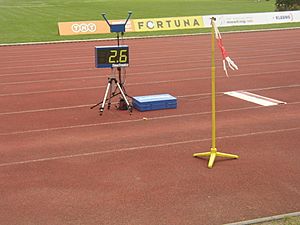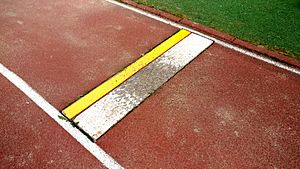Long jump facts for kids
The long jump is an exciting sport in track and field. In this event, athletes try to jump as far as they can into a pit filled with soft sand. It's all about how far you can leap! If a jumper falls backward after landing, it can make their jump shorter, so landing well is key.
Contents
Rules of the Long Jump
Long jumpers run down a special track, usually made of a rubbery surface like other running tracks. They jump from a wooden board that's about 20 centimeters (8 inches) wide. This board is flat with the runway. If any part of the jumper's foot goes past the foul line (the edge of the board) before they jump, it's called a foul, and that jump doesn't count. A special soft material is sometimes placed right after the board to help officials see if a foul happened.
Jumpers can start their leap from anywhere behind the foul line. However, the distance is always measured from the foul line to the closest mark their body or uniform makes in the sand. So, it's best for jumpers to get as close to the line as possible without crossing it! Athletes are allowed to place two small markers on the side of the runway to help them start their run accurately.
Attempts and Winning
Each competitor usually gets a certain number of tries, often three. The best 8 or 9 jumpers then get three more jumps in a final round. All legal jumps are recorded, but only the longest legal jump counts towards the final result. The athlete with the longest legal jump at the end of the competition wins! If there's a tie, officials look at the next best jumps of the tied athletes to decide the winner.
For a jump to count as a record, the wind helping the jumper must be less than two meters per second (about 4.5 miles per hour).
Long Jump Technique
There are five main parts to a successful long jump: the run-up, the last two steps, the takeoff, what the jumper does in the air, and the landing. Being fast during the run-up and having a strong leap off the board are super important for a long jump. Many great long jumpers are also fast sprinters because speed is so crucial! A famous example is Carl Lewis, who was amazing at both.
The Approach Run
The goal of the approach run is to slowly get faster until the jumper reaches their fastest controlled speed right before they jump. The faster a jumper is when they leave the ground, the farther they will go. Elite jumpers usually leave the ground at a low angle, so focusing on speed is more helpful than trying to jump very high.
The length of the run-up is usually the same for each athlete. It can be between 12 and 19 steps for beginners, and 20 to 22 steps for experienced jumpers. Getting the run-up consistent is important so the jumper can hit the takeoff board perfectly without fouling.
The Last Two Strides
These last two steps are very important because they get the body ready for takeoff while keeping as much speed as possible. The second-to-last step is usually longer than the very last step. The jumper starts to lower their body a bit to prepare for the jump upwards. The final step is shorter as the body begins to rise for the takeoff.
Takeoff
The goal of the takeoff is to push the body upwards while staying balanced and in control. This is one of the trickiest parts of the long jump. Jumpers need to make sure their foot lands flat on the board. If they jump off their heels, it can slow them down. If they jump off their toes, they might lose balance. While focusing on foot placement, athletes also need to keep their body upright and push their hips forward and up to get the most distance.
There are different styles of takeoff:
- Kick style: The athlete actively moves their leg in a cycling motion before pushing off the board. This needs strong leg muscles.
- Double-arm style: Both arms move upwards as the jumper takes off. This helps the jumper get more height.
- Sprint style: This is a common style where the arm action looks like a sprinter running fast. It helps keep speed through the takeoff.
- Power sprint or bounding style: Similar to the sprint style, but the arm on the side of the takeoff leg extends fully backward. This gives an extra push.
The best takeoff style depends on each individual athlete.
Action in the Air and Landing
Once a jumper is in the air, they can't change the direction they are going. However, what they do in the air can help them land better and get a longer measurement. For example, if a jumper lands feet first but then falls backward, their jump will be measured from where their body touched the sand last, which makes the jump shorter.
There are three main ways jumpers try to control their body in the air:
- The hang: The jumper holds a "hanging" position.
- The sail: The jumper extends their body like a sail.
- The hitch-kick: The jumper makes a cycling motion with their legs, like running in the air.
In the 1970s, some jumpers tried a forward somersault jump. This jump might have allowed for longer distances, but it was later banned because it was considered unsafe.
Training for Long Jump
Long jumpers train in several ways to improve their performance.
Speed Work
Speed work means short, fast running drills where athletes run at or near their top speed. These runs are usually between 30 and 100 meters. This helps jumpers get faster for their approach run.
Jumping Practice
Long jumpers usually practice jumping one to two times a week. They do "run-throughs" (approach runs without jumping) many times to make sure their steps are consistent. They also do "short approach jumps" to work on specific parts of their technique in a controlled way. Using small hurdles or other obstacles can help jumpers practice different parts of their jump. It's important for jumpers to do full approach jumps at least once a week to get ready for competitions.
Over-Distance Running
This type of training helps jumpers build their endurance. For example, a jumper might run 200-meter repeats to improve their sprint endurance. This is important because they sprint down the runway several times in a competition.
Weight Training
Weight training is a big part of a long jumper's training, especially before and early in the competition season. Jumpers often lift weights up to four times a week, focusing on quick, explosive movements for their legs and core. They use lower repetitions but emphasize speed to build strength without adding too much extra weight. Important exercises include squats and cleans, which help with the powerful takeoff.
Plyometrics
Plyometrics are exercises that involve explosive jumps, like running up and down stairs or jumping over hurdles. These help athletes become more agile and explosive. Box jumps are another common plyometric exercise where jumpers leap onto and off boxes of different heights. These workouts are usually done at the end of a training session.
Bounding
Bounding means continuous jumping or leaping. Bounding drills can involve jumping on one leg, two legs, or a mix of both. The main goal is to spend as little time on the ground as possible and to improve jumping endurance and strength. Bounding is a type of plyometric exercise.
Flexibility
Flexibility is very important for long jumpers. Being flexible helps prevent injuries, which is crucial for a high-impact sport like the long jump. It also helps athletes sprint better down the runway. Hip and groin injuries are common if jumpers don't warm up and stretch properly.
Hurdle mobility drills are a good way to improve flexibility. Athletes walk or skip over a line of hurdles to stretch their hips and legs.
Video Taping
Many long jumpers use video taping during their training. This allows them to watch their own jumps and see their progress. They can also compare their technique to that of world-class jumpers to learn and improve.
Related pages
Images for kids
-
Sand pit where Bob Beamon set the 8.90 m record in Mexico City
See also
 In Spanish: Salto de longitud para niños
In Spanish: Salto de longitud para niños








